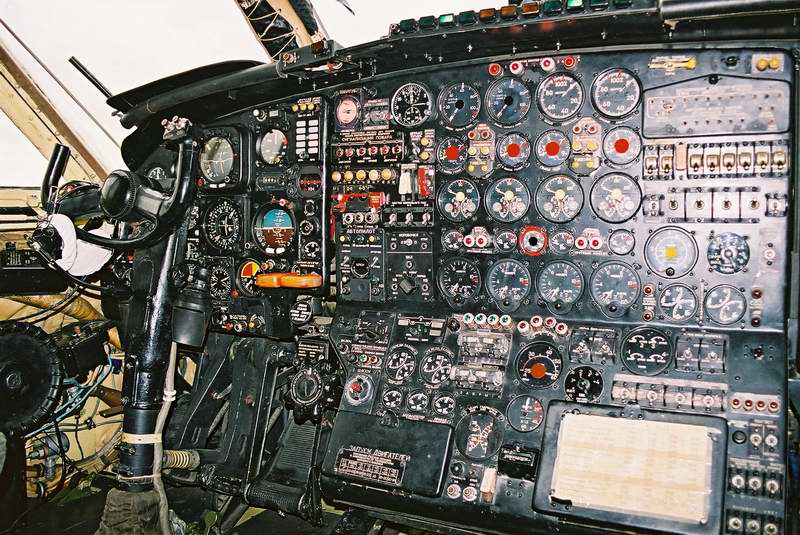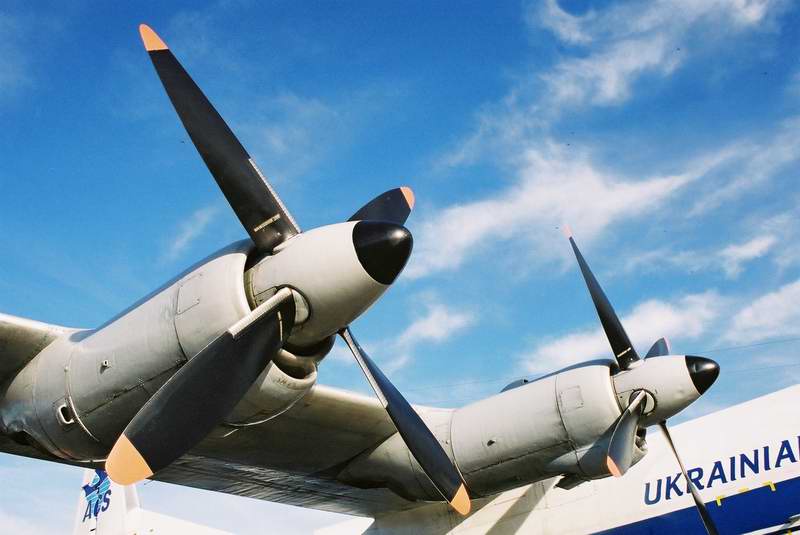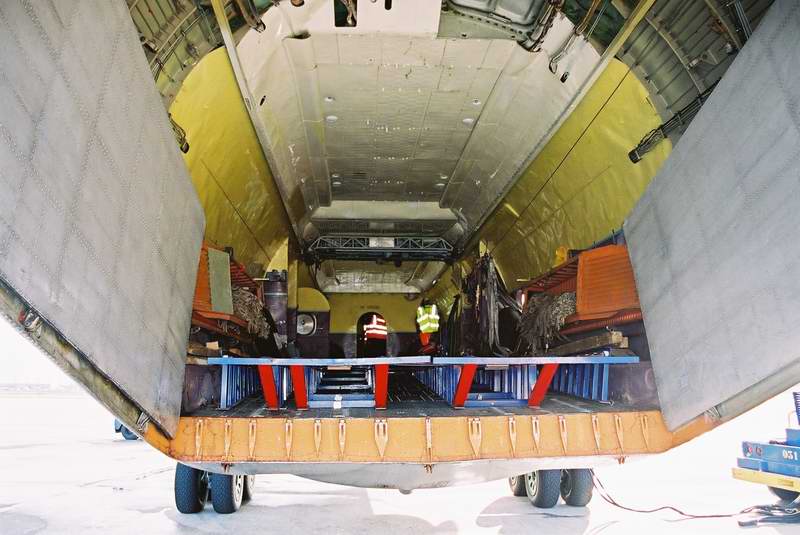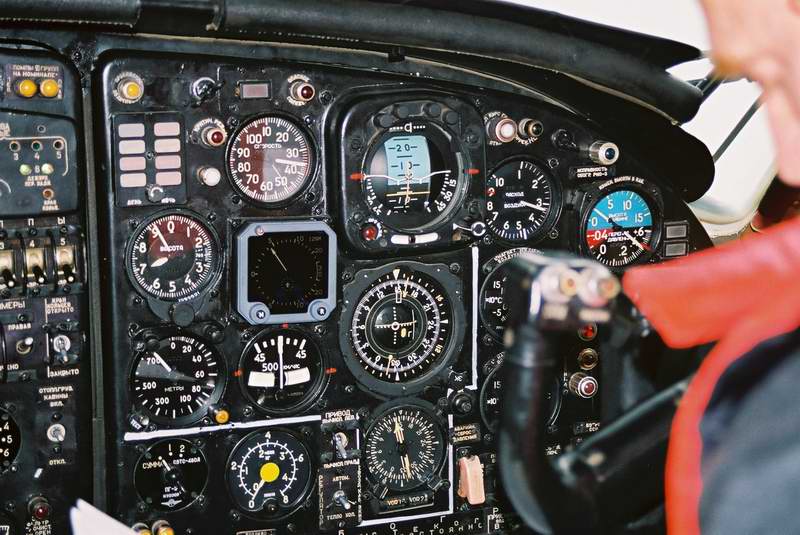“Chicken Kiev” - onboard a Budapest bound “Antonov”
A roaring Ukrainian Cargo Airways Antonov 12, still plying its trade
in the ever turbulent cargo charter market of Western Europe.
By Jan Koppen
|
Due to a sudden lack of freight capacity during November 2002, Ukrainian Cargo Airways Antonov 12 UR-UCK was chartered to operate a trans european flight for a major Dutch airline. The flight routed from Amsterdam to Budapest and then returning back to UCA’s temporary base in Ostend, Belguim, with the cargo finally forwarded by road to Amsterdam.
I had admired the Russian turboprop-freighters for a long time and enjoyed seeing them take off from Amsterdam Schiphol airport, on many occasion. I found a possiblity to secure a “ride on the jumpseat” on above mentioned flight and arrived around 11.30 hours at the AviaTrading cargo-ramp at Schiphol-South. At 11.47 a trail of black smoke could be seen lining up for runway 06 some five miles to the south of the airport. Two minutes later, laying four smokey trails across the polder, the An-12 roared into touch down. The russian build freighter shuddered to a noisy stop as the props were thrown into reverse. Please to meet you The broker’s liason officer introduced me to the crew for the upcoming flight. A veteran in An-12 operations, Captain Tikhnenko, a man of few words, would be commander of our flight. The other cockpit members comprised; Co-pilot Shamarin, Flight Engineer Yuschenko, Navigator Minakov, Radio Operator Nikonov, Ground-engineers Garbuza and Torshyn. These blond, muscular men more looked like the Ukrainian Olympic wrestling team than an An-12 flightcrew ! Our radio operator, resplendent in a grey, and one time Ukrainian AirForce overall, was next to the broker’s liason officer, the only crew member with knowledge of the english language. He gave me a run down of the flightdeck and procedures in case of an emergency. The flightdeck was as it would have appeared in the 60s, except for the addition of a GPS navigation aid system. Fortunately the An-12 has a spacious cabin situated behind the cockpit to give place to all these crewmembers and this section is pressurised together with the cockpit. Due to these features it looks like you have entered a Russian submarine ! The round, slender body of the An-12 features a stepped cockpit and glassed-in nose, with the landing gear housed within external blisters. The somewhat elevated tail and a big cargo hatch (10 ft x 8 ft) ensures the convenient loading and unloading of large-size cargoes. The freighter was fitted out with a custom-made roller track system floor to enable the easy loading and unloading of pallets. Its large volumetric hold can carry up to four “P6P” pallets and has a internal crane. The An-12’s sturdy construction can handle a maximum cargo payload of an impressive 15,000 kg. Ukrainian Cargo Airways is acting as the state enterprise on the market of air transportation since 1997. Their headquarters is in the city of Zaporizhia, Ukraine. The fleet of Il-76’s, Il-78’s, An-12’s, An-26’s, Tu-154B-2’s and Mil-8 helicopters are based in Kryvyi Rig and Melitopol. The aircraft, UR-UCK (c/n. 9346905), a An-12BK “Cub” of the early 1960s, had previously seen service with Ukrainian Cargo and Veteran Airlines under registration UR-11304. The first owner was the “Red Star Air Fleet” and consequently she still had the tail turret, ofcourse without its double-barreled machine-guns. Our load of four pallets giving 8,5 tonnes payload was in the final stages of loading which was simply done with the help of a forklift-truck. 6000kg of fuel was ordered and some minutes later a Shell refueller proceeded to replenish the tanks as requested. We would burn an estimated 2,400 kg of fuel per hour. After Co-pilot Shamarin had checked the weather, finalised the flightplan and paid the groundhandler, I joined him for the final walkround and then boarded the aircraft via the hatchway under the cockpit, as the side-door was block by the cargo. The An-12 performance is:
Cruise Speed: 416 mph (670km/h) Max Speed: 482 mph (777km/h) Range with Max Payload: 1,492 nm (3,600km) Range with Max Fuel: 3,075 nm (5,700km) Service Ceiling: 33,500 feet (10,200m) UR-UCK awaits her next assignment at Amsterdam.
|
View looking forward through and beneath the cockpit, with the navigator’s station in the very nose of the aircraft.
The An-12 has become popular on aerial tramping missions to airports across the world.
Close-up of the nose of UR-UCK showing the navigator’s station and the under nose radar pod.
The aircraft has a maximum payload of 15 ton.
|
Note the pair of fans to provide cooling for the pilots.
|
Time to go
At 12.30Z “Uniform Kilo 345” (our flight number UKS0345) called Schiphol ground for start clearance, which was duly received, and with the pre-start checklist completed No. 1 starter was engaged. In less than a minute the 4,000 shp Ivchenko AI-20K engine, driving AV68 four blade constant speed propellers, was stabilised at low speed. Numbers 2, 4 and 3 were then started, taxi clearance was given and with Number 1 and 4 upshifted to high speed, we powered out towards the hold for runway 19L. With the deafening deeply-pitched roar of the Ivechenko’s piercing our ears, we had to wait on departing traffic before lining up. A KLM Boeing 737 followed by a Iberia Airbus departed within some minutes after each other. During the hold for 19L the other 2 engines were upshifted and with clearance given Tikhnenko steered us onto the runway and lined up on the “zebra crossing”. With our Captain handling the aircraft, the brakes were applied and the throttles advanced to take off power. After the brakes were released, we lurched forward. Rotation occurred at 105 Kts. at 12.51Z, and after an intial climb rate of 1600ft/min, and landing gear retraction at 900ft, we poured a fresh smoke supply over the polder just aft of the threshold. With the cabin reverberating to the deep roar of the Ivchenko turboprops, speed was maintained at 160kts and the climb rate reduced to 900ft/min, followed by a slight left turn onto heading 186 degrees and climb to 4000ft. Yuschenko constantly monitored the engine instruments and made fine adjustments to the power levers to keep each engine at the same power setting. At 12.57Z Amsterdam control cleared us to 27000ft (approximate 8600 meters according the russian altimeter) and instructed us to contact Dusseldorf control. They directed us onto a heading of 157 degrees to the “ARP” beacon. Climbing out to our assigned cruising altitude, we overflew Germany’s industrial Rhur district. Despite the heavy din, the An-12 cockpit is relatively quiet and vibration-free at climb and cruise power. Bon appetit ! Once we had settled into our cruise, one of the engineers served some of Ukrainian’s finest cuisine in the crew rest area of the An-12. The maindish consisted of boiled chicken (perhaps “Chicken Kiev”) and as dessert a thick slice of fatty bacon with fresh tomatos; – I refused politely ! Dusseldorf gave various heading changes but we maintained our height and arrived over the Fulda VOR at 13.54Z. Then turned onto a heading of 132 degrees for beacon LNZ. Handing over to Linz control at 14.35Z the elevation of the ground ahead rose, snow could be seen on the higher slopes and an increasing illumination becoming visible as dusk caught the lumbering Antonov. An opportunity to listen into the airwave for a change, produced little traffic, with only some Tyrolean commuters working the frequency. Final stage At 14.57Z the descent was initialised and the throttles were retarded to give 1300hp and the descent rate increased to 1000ft/min with an airspeed of 250kts. 15.05Z and Bratislava control instructed a descent to 17,000ft, change heading to 095 degrees and to contact Budapest on 120,375. We reported our position and gave our speed. After several minutes in descent we levelled off at 9500ft and Yuschenko throttled back to give 800hp on each engine. Budapest approach gave further successive headings to put us on an intersection with the runway Instrument Landing System (ILS). Overhead the city, with its illuminated historic buildings and bridges, Ferihegy Tower was contacted 5 miles out and we were cleared to land on runway 13R with a windspeed of 10kts from 180 degrees at 5 degrees Celcius. With localiser capture, the final checks were carried out and gear and flaps selected. We watched Tikhnenko grapple with the ILS down to short finals as runway 13R grew ever closer. As we crossed the perimeter fence Tikhnenko brought his plane exactly on track and made a smooth touchdown exactly at 16.32 local time. Props went into reverse and we came to a noisy stop abeam the cargo terminal. Following the receipt of parking instructions from the tower to taxy to our designated stand, we pulled up next to a DHL Airbus 300F, registrated OO-DLR and spooled down the powerplants. Our sturdy Antonov behaved impeccably and performed her duties perfectly ! The cockpit hatch was opened followed by the cargo door at the rear of the aircraft. Our Hungarian airline representative and his groundcrew was on hand to meet the aircraft, and the pallets were off-loaded within a few minutes. New cargo was also quickly loaded and the aircraft refuelled. At 18.25LT, UR-UCK, using callsign ‘Uniform Kilo Sierra 346‘, smoked her way out of Ferihegy airport into the dark of the evening, en-route to its temporary home at Ostend Airport, Belgium. I left Budapest the next moring on a regular-flight to Amsterdam. Hopefully our leviathan will keep finding more lucrative opportunities to earn its keep and be around for many more years to come. I want to thank my colleage Mr. Rob Williams of the West Midlands, England, for his editorial consultancy. |
The stupendous din of number 1 & 2 4,000 h.p. Ivchenko AI-20K turboprops.
|



















